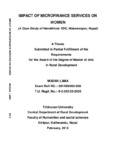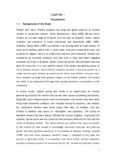Please use this identifier to cite or link to this item:
https://elibrary.tucl.edu.np/handle/123456789/2357| Title: | Impact of Microfinance Services on Women: A Case Study of Handikhola VDC, Makawanpur, Nepal |
| Authors: | Lama, Madan |
| Keywords: | Microfinance;Cooperatives;Women empowerment;Makawanpur;Women |
| Issue Date: | Feb-2012 |
| Publisher: | Central Department of Rural Development Tribhuvan University, Kathmandu |
| Abstract: | This is a study of impacts of micro finance service provided by Mahila Sahayogi Sahakari Sastha (MSSS) specifically its economic impacts, areas of loan and income investment, problems faced by women, unintended consequences as well as social status of women members in Handikhola VDC of Makawanpur district.The objectives of this research entail i) advantages of micro-finance programs to rural women, ii) to identify priority areas at which women have used the credit received from their micro-finance and iii) to find out the problems faced by women in their socio-economic activities on saving/credit program. Review of micro finance programs have indicated that the primary obstacles to access remain appropriate and bureaucratic procedures, prohibitive collateral requirements; and excessively high transaction costs incur by both lender and borrower. Recent initiative like the Micro-Credit Project for the Women (MCPW) sponsored by the ministry of local development and various governmental and non-governmental clan of the Gramin Bank have served to modify women's picture. To achieve the targeted objectives certain data collection methods like interview schedule, observation, key informant interview, focus group discussion, and case study were used. Purposive and simple random sampling research designs were used in this study. Out of total sample size, 50% women were Brahmin and Chherti community, 45% were Newars, 3.3% were Tamang and 1.7% were Dalits. 5% of women were illiterate, 20% were literate from non formal education and other campaign of education, 25% of women had completed primary level education, 18.7% were in lower secondary, and 20% women had studied secondary level. 11.3% of women had completed SLC and higher education. MSSS has invested Rs.1415000 loan among 60 women of three wads of Handikhola. 40% have taken loan personally range Rs. 16000-25000. According to the loaned women this is not adequate amount to start new occupation but some women started new income generating occupation by adding extra money from other sources. 25% of the respondents had taken the amount of Rs. 26000-35000 and 11.7% of the women had taken relatively largest amount range from Rs.36000-50000, and 13.3% women had taken less than Rs. 10000. Most of women were trained but not all trained women involved on the same occupation they have been trained. For example 17 women had received tailoring training but only 8 women are involving tailoring as income occupation. Similarly 14 women had been trained on beauty parlor but only 10 women applied parlor as an income occupation. vi The areas of income investment show that 55% of women expensed on food purchasing for the family, one woman had invested to buy land, 5% of them invested their income on house construction, 15% of them invested on entertainment and utensils in the home, 50% have invested on children's education, 45% replied on health, 49% have expensed on further development of the present occupations and loan returning of the office, 40% have already returned loan received from the MSSS, and 90% have been saving their income in the bank. There were various problems faced by women members of MSSS program. There were cases of unintended consequences of micro-credit program. When loaned women ran away or died their remaining family members denied to return loan. This types of event gradually loses security of loan credibility of other women members in different. MSSS always doubts upon the security of loan among women. Thus, we can say that micro-finance services are strong but not ultimate tool for women's empowerment and poverty reduction among women. It is relative with socio-cultural as well as economic background of the family and society. Family support both physically and morally is backbone of occupational development otherwise confidence, boldness and tolerance is essential for women. In spite of various constraints majority of women member have done income generation. They were gaining not only economic status but also developed social linkages through line agencies, involved in social developmental activities and all-round development. Last but not least, social and cultural empowerment is necessary for the participation of lower strata of the society. And women's education is the basic backbone of empowerment. Government put stress on girl education. Furthermore, policies of micro finance organizations and installment payment date should be flexible because most women would have been in tensed mood at the time of installment. For this, women empowerment, social justice and gender equity is a must. |
| URI: | http://elibrary.tucl.edu.np/handle/123456789/2357 |
| Appears in Collections: | Rural Development |
Files in This Item:
| File | Description | Size | Format | |
|---|---|---|---|---|
| Cover.pdf | 190.73 kB | Adobe PDF |  View/Open | |
| Thesis Body.pdf | 557.61 kB | Adobe PDF |  View/Open |
Items in DSpace are protected by copyright, with all rights reserved, unless otherwise indicated.
